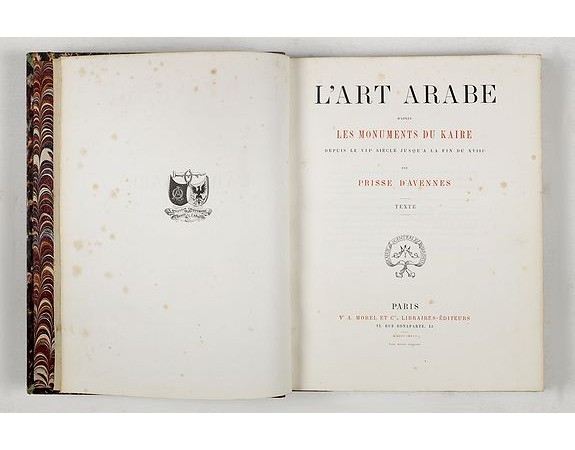PRISSE D'AVENNES, Achille Constant. - L'Art arabe d'après les monuments du Kaire depuis le VIIe siècle jusqu'à la fin du XVIIIe.

PRISSE D'AVENNES, Achille Constant. - L'Art arabe d'après les monuments du Kaire depuis le VIIe siècle jusqu'à la fin du XVIIIe.
Published: Paris, Morel, 1877
Size: 573 x 402mm.
Color: Uncoloured.
Condition: Text vol. in 4to (325 x 245mm) in half red Shagreen and 199 (of 200) plates in tall folio (573 x 402mm.). Text: (ii) + (viii) + 296 pp with 34 engraved plates. Plates are lithographed or engraved, approximately 130 printed in colours. Spotting troughout text and plates, water staining affecting a few plates, titles and tables of third volume. Some original publisher’s wrappers remain with the mention of second edition.
Description
Rare et remarquable ouvrage sur l'Orient, le plus important du XIXe siècle entièrement consacré à l'art arabe.
Illustré de 199 (sur 200) planches.
Il contient des vues lithographiées d'après le grand photographe Giraud de Prangey (1804-1892), l'un des premiers voyageurs français à prendre des photographies au Caire et à Jérusalem. Les photographies de Girault de Prangey figurent parmi les plus anciennes que l’on connaisse de l’Orient.
Les planches, lithographiées en couleurs ou teintées, représentent des vues de vestiges (extérieur et intérieur) et des détails d'ornementations (portes, heurtoirs, flambeaux, plats), armes, émaux, tapis, manuscrits et Corans.
Mention de "deuxième édition" sur les chemises, texte édité à Paris, Ve A. Morel et C.ie, libraires-éditeurs - 13, rue Bonaparte, 13.
- Prisse d’Avennes was one of the foremost scholars of Arabic art and architecture of the 19th century; this work represents the summation of his studies. From the aspect of chromolithography, this ranks as one of the greatest accomplishments of the medium.
This important work illustrates all aspects of Islamic art, including architecture, woodwork, tiling, interiors, furniture, arms and armour, glass and enamels, carpets, manuscripts and Korans.
Illustrated with 199 (of 200) plates, some are engraved after the great Photographer Giraud de Prangey (1804-1892), who was one of the first French travellers to take photographs in Cairo and Jerusalem.
Mention of second edition on original publisher’s wrappers, text published in Paris, Ve A. Morel et C.ie, libraires-éditeurs - 13, rue Bonaparte, 13.
Not in Blackmer or Atabey.
« L’Art arabe d’après les monuments du Kaire depuis le VIIe siècle jusqu’à la fin du XVIIIe by Émile Prisse d’Avennes, was published in four volumes by V.A. Morel in Paris between 1869 and 1877. Its 200 chromolithographs, depicting in extraordinary detail a large range of Islamic religious and domestic architecture and decoration, predominantly from Egypt, were a remarkable technical achievement. No less impressive were the 300 pages of text comprising a detailed chronicle of the geography, history and monuments of Egypt from the Arab conquest to the French invasion in 1798, as well as descriptions of the individual buildings and artefacts chosen for the plates, carefully classified to show the artistic development of each group.
……. These plates and their explanations were based on Prisse’s extensive and thoroughgoing observations made during his many years of residence in Egypt. Between 1827 and 1844 he worked first for Muhammad Ali as an engineer and teacher, and then independently, exploring the country’s ancient monuments along the Nile as far as Nubia. Dressing and living as a Muslim, and having mastered both classical Arabic and the local dialects, he was well placed to study and understand Egyptian society. At the same time he knew and exchanged scholarly expertise with other long-term foreign residents, but only a few of these equalled his ability so effectively to cross the cultural boundaries between East and West.
….. The plates are the results of Prisse’s collaboration with other artists, a complex process that has not yet been fully disentangled. They reflect his considerable skills as a draughtsman, but also his reliance on early photographs of Egyptian monuments. When he returned to Egypt in 1858-60 for a second visit, Prisse brought with him not only the young Dutch artist, Willem de Famars Testas, but also a photographer, Edouard (baptised Anasthase) Jarrot. The work produced by all three men, as well as material from other sources, is contained in the extensive holdings of his papers at the Bibliothèque Nationale de France, and is currently undergoing research.” (Briony Llewellyn and Mercedes Volait).
Illustré de 199 (sur 200) planches.
Il contient des vues lithographiées d'après le grand photographe Giraud de Prangey (1804-1892), l'un des premiers voyageurs français à prendre des photographies au Caire et à Jérusalem. Les photographies de Girault de Prangey figurent parmi les plus anciennes que l’on connaisse de l’Orient.
Les planches, lithographiées en couleurs ou teintées, représentent des vues de vestiges (extérieur et intérieur) et des détails d'ornementations (portes, heurtoirs, flambeaux, plats), armes, émaux, tapis, manuscrits et Corans.
Mention de "deuxième édition" sur les chemises, texte édité à Paris, Ve A. Morel et C.ie, libraires-éditeurs - 13, rue Bonaparte, 13.
- Prisse d’Avennes was one of the foremost scholars of Arabic art and architecture of the 19th century; this work represents the summation of his studies. From the aspect of chromolithography, this ranks as one of the greatest accomplishments of the medium.
This important work illustrates all aspects of Islamic art, including architecture, woodwork, tiling, interiors, furniture, arms and armour, glass and enamels, carpets, manuscripts and Korans.
Illustrated with 199 (of 200) plates, some are engraved after the great Photographer Giraud de Prangey (1804-1892), who was one of the first French travellers to take photographs in Cairo and Jerusalem.
Mention of second edition on original publisher’s wrappers, text published in Paris, Ve A. Morel et C.ie, libraires-éditeurs - 13, rue Bonaparte, 13.
Not in Blackmer or Atabey.
« L’Art arabe d’après les monuments du Kaire depuis le VIIe siècle jusqu’à la fin du XVIIIe by Émile Prisse d’Avennes, was published in four volumes by V.A. Morel in Paris between 1869 and 1877. Its 200 chromolithographs, depicting in extraordinary detail a large range of Islamic religious and domestic architecture and decoration, predominantly from Egypt, were a remarkable technical achievement. No less impressive were the 300 pages of text comprising a detailed chronicle of the geography, history and monuments of Egypt from the Arab conquest to the French invasion in 1798, as well as descriptions of the individual buildings and artefacts chosen for the plates, carefully classified to show the artistic development of each group.
……. These plates and their explanations were based on Prisse’s extensive and thoroughgoing observations made during his many years of residence in Egypt. Between 1827 and 1844 he worked first for Muhammad Ali as an engineer and teacher, and then independently, exploring the country’s ancient monuments along the Nile as far as Nubia. Dressing and living as a Muslim, and having mastered both classical Arabic and the local dialects, he was well placed to study and understand Egyptian society. At the same time he knew and exchanged scholarly expertise with other long-term foreign residents, but only a few of these equalled his ability so effectively to cross the cultural boundaries between East and West.
….. The plates are the results of Prisse’s collaboration with other artists, a complex process that has not yet been fully disentangled. They reflect his considerable skills as a draughtsman, but also his reliance on early photographs of Egyptian monuments. When he returned to Egypt in 1858-60 for a second visit, Prisse brought with him not only the young Dutch artist, Willem de Famars Testas, but also a photographer, Edouard (baptised Anasthase) Jarrot. The work produced by all three men, as well as material from other sources, is contained in the extensive holdings of his papers at the Bibliothèque Nationale de France, and is currently undergoing research.” (Briony Llewellyn and Mercedes Volait).
8,000€
- See other items by this publisher: PRISSE D'AVENNES, Achille Constant.
- Reference N°: 64992
4659 views
 Click on image to zoom
Click on image to zoom
